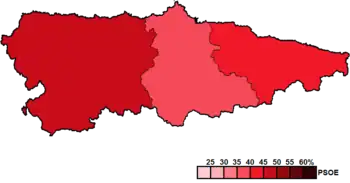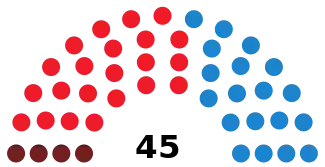2003 Asturian regional election
The 2003 Asturian regional election was held on Sunday, 25 May 2003, to elect the 6th General Junta of the Principality of Asturias. All 45 seats in the General Junta were up for election. The election was held simultaneously with regional elections in twelve other autonomous communities and local elections all throughout Spain.
| |||||||||||||||||||||||||||||||||||||||||||||
All 45 seats in the General Junta of the Principality of Asturias 23 seats needed for a majority | |||||||||||||||||||||||||||||||||||||||||||||
|---|---|---|---|---|---|---|---|---|---|---|---|---|---|---|---|---|---|---|---|---|---|---|---|---|---|---|---|---|---|---|---|---|---|---|---|---|---|---|---|---|---|---|---|---|---|
| Opinion polls | |||||||||||||||||||||||||||||||||||||||||||||
| Registered | 976,104 | ||||||||||||||||||||||||||||||||||||||||||||
| Turnout | 623,149 (63.8%) | ||||||||||||||||||||||||||||||||||||||||||||
| |||||||||||||||||||||||||||||||||||||||||||||
 Constituency results map for the General Junta of the Principality of Asturias | |||||||||||||||||||||||||||||||||||||||||||||
| |||||||||||||||||||||||||||||||||||||||||||||
Overview
Electoral system
The General Junta of the Principality of Asturias was the devolved, unicameral legislature of the autonomous community of Asturias, having legislative power in regional matters as defined by the Spanish Constitution and the Asturian Statute of Autonomy, as well as the ability to vote confidence in or withdraw it from a regional president.[1]
Voting for the General Junta was on the basis of universal suffrage, which comprised all nationals over 18 years of age, registered in Asturias and in full enjoyment of their political rights. The 45 members of the General Junta of the Principality of Asturias were elected using the D'Hondt method and a closed list proportional representation, with an electoral threshold of three percent of valid votes—which included blank ballots—being applied in each constituency. Seats were allocated to constituencies, which were established by law as follows:
- Central District, comprising the municipalities of Aller, Avilés, Bimenes, Carreño, Caso, Castrillón, Corvera de Asturias, Gijón, Gozón, Illas, Las Regueras, Langreo, Laviana, Lena, Llanera, Mieres, Morcín, Noreña, Oviedo, Proaza, Quirós, Ribera de Arriba, Riosa, San Martín del Rey Aurelio, Santo Adriano, Sariego, Siero, Sobrescobio and Soto del Barco.
- Eastern District, comprising the municipalities of Amieva, Cabrales, Cabranes, Cangas de Onís, Caravia, Colunga, Llanes, Nava, Onís, Parres, Peñamellera Alta, Peñamellera Baja, Piloña, Ponga, Ribadedeva, Ribadesella and Villaviciosa.
- Western District, comprising the municipalities of Allande, Belmonte de Miranda, Boal, Candamo, Cangas del Narcea, Castropol, Coaña, Cudillero, Degaña, El Franco, Grado, Grandas de Salime, Ibias, Illano, Muros de Nalón, Navia, Pesoz, Pravia, Salas, San Martín de Oscos, Santa Eulalia de Oscos, San Tirso de Abres, Somiedo, Tapia de Casariego, Taramundi, Teverga, Tineo, Valdés, Vegadeo, Villanueva de Oscos, Villayón and Yernes y Tameza.
Each constituency was allocated an initial minimum of two seats, with the remaining 39 being distributed in proportion to their populations.[2]
The use of the D'Hondt method might result in a higher effective threshold, depending on the district magnitude.[3]
The electoral law allowed for parties and federations registered in the interior ministry, coalitions and groupings of electors to present lists of candidates. Parties and federations intending to form a coalition ahead of an election were required to inform the relevant Electoral Commission within ten days of the election call, whereas groupings of electors needed to secure the signature of at least one percent of the electorate in the constituencies for which they sought election, disallowing electors from signing for more than one list of candidates.[2][4]
Election date
The term of the General Junta of the Principality of Asturias expired four years after the date of its previous election. Elections to the General Junta were fixed for the fourth Sunday of May every four years. The previous election was held on 13 June 1999, setting the election date for the General Junta on Sunday, 25 May 2003.[1][2][4]
The president had the prerogative to dissolve the General Junta and call a snap election, provided that no motion of no confidence was in process, no nationwide election was due and some time requirements were met: namely, that dissolution did not occur either during the first legislative session or within the legislature's last year ahead of its scheduled expiry, nor before one year had elapsed since a previous dissolution under this procedure. In the event of an investiture process failing to elect a regional president within a two-month period from the first ballot, the General Junta was to be automatically dissolved and a fresh election called. Any snap election held as a result of these circumstances would not alter the period to the next ordinary election, with elected deputies merely serving out what remained of their four-year terms.[1]
Opinion polls
The table below lists voting intention estimates in reverse chronological order, showing the most recent first and using the dates when the survey fieldwork was done, as opposed to the date of publication. Where the fieldwork dates are unknown, the date of publication is given instead. The highest percentage figure in each polling survey is displayed with its background shaded in the leading party's colour. If a tie ensues, this is applied to the figures with the highest percentages. The "Lead" column on the right shows the percentage-point difference between the parties with the highest percentages in a poll. When available, seat projections determined by the polling organisations are displayed below (or in place of) the percentages in a smaller font; 23 seats were required for an absolute majority in the General Junta of the Principality of Asturias.
- Color key:
Exit poll
| Polling firm/Commissioner | Fieldwork date | Sample size | Turnout | URAS | PAS | Lead | |||
|---|---|---|---|---|---|---|---|---|---|
| 2003 regional election | 25 May 2003 | — | 63.8 | 40.5 22 |
39.2 19 |
11.0 4 |
2.8 0 |
1.8 0 |
1.3 |
| Sigma Dos/Antena 3[p 1] | 25 May 2003 | ? | ? | ? 21/22 |
? 18 |
? 4/5 |
– | – | ? |
| Ipsos–Eco/RTVE[p 2] | 25 May 2003 | ? | ? | ? 22/24 |
? 16/18 |
? 5/6 |
– | – | ? |
| InvesMark/El Comercio[lower-alpha 1][p 3] | 2–8 May 2003 | 1,600 | 61.5 | 48.6 24/25 |
30.8 15/16 |
9.6 3/4 |
4.9 1 |
2.4 0/1 |
17.8 |
| CIS[p 4][p 5] | 22 Mar–28 Apr 2003 | 1,287 | 73.0 | 45.7 24 |
30.7 16 |
11.2 4 |
4.8 1 |
– | 15.0 |
| Vox Pública/El Periódico[p 6][p 7] | 23–24 Apr 2003 | 802 | ? | 48.0– 49.0 25/26 |
28.5– 29.5 14/15 |
? 3/4 |
? 2 |
– | 19.5 |
| CIS[p 8][p 9][p 10] | 9 Sep–9 Oct 2002 | 493 | 72.0 | 45.8 | 31.5 | 9.7 | 1.0 | – | 14.3 |
| 2000 general election | 12 Mar 2000 | — | 67.0 | 37.0 | 46.3 | 10.3 | 2.0 | 0.9 | 9.3 |
| 1999 regional election | 13 Jun 1999 | — | 63.6 | 46.0 24 |
32.3 15 |
9.0 3 |
7.1 3 |
2.6 0 |
13.7 |
Results
Overall
 | ||||||
| Parties and alliances | Popular vote | Seats | ||||
|---|---|---|---|---|---|---|
| Votes | % | ±pp | Total | +/− | ||
| Spanish Socialist Workers' Party (PSOE) | 250,474 | 40.48 | –5.52 | 22 | –2 | |
| People's Party (PP) | 242,396 | 39.18 | +6.87 | 19 | +4 | |
| United Left–Bloc for Asturias (IU–BA) | 68,360 | 11.05 | +2.05 | 4 | +1 | |
| Asturian Renewal Union (URAS) | 17,552 | 2.84 | –4.30 | 0 | –3 | |
| Asturianist Party (PAS) | 11,376 | 1.84 | –0.74 | 0 | ±0 | |
| The Greens–Green Left of Asturias (LV–IVA) | 6,561 | 1.06 | +0.52 | 0 | ±0 | |
| Andecha Astur (AA) | 3,821 | 0.62 | +0.26 | 0 | ±0 | |
| Senior Defense Platform (PlaDeTE) | 1,297 | 0.21 | New | 0 | ±0 | |
| Communist Party of the Peoples of Spain (PCPE)1 | 1,211 | 0.20 | –0.02 | 0 | ±0 | |
| Democratic and Social Centre (CDS) | 642 | 0.10 | –0.02 | 0 | ±0 | |
| Asturian Council (Conceyu) | 524 | 0.08 | ±0.00 | 0 | ±0 | |
| Asturian Democratic Convergence (CDAS) | 359 | 0.06 | New | 0 | ±0 | |
| Blank ballots | 14,143 | 2.29 | +0.72 | |||
| Total | 618,716 | 45 | ±0 | |||
| Valid votes | 618,716 | 99.29 | –0.11 | |||
| Invalid votes | 4,433 | 0.71 | +0.11 | |||
| Votes cast / turnout | 623,149 | 63.84 | +0.22 | |||
| Abstentions | 352,955 | 36.16 | –0.22 | |||
| Registered voters | 976,104 | |||||
| Sources[5][6][7] | ||||||
Footnotes:
| ||||||
Aftermath
| Investiture | |||
| Ballot → | 4 July 2003 | ||
|---|---|---|---|
| Required majority → | 23 out of 45 | ||
26 / 45 |
|||
Abstentions
|
19 / 45 | ||
| Absentees | 0 / 45 | ||
| Sources[7][8] | |||
Notes
- Undecided and/or abstentionists excluded.
References
- Opinion poll sources
- "El sondeo de Sigma Dos determina una lucha codo a codo entre populares y socialistas en Madrid". ABC Sevilla (in Spanish). 25 May 2003. Archived from the original on 25 May 2019. Retrieved 19 May 2019.
- "Sondeo a pie de urna de Ipsos Eco Consulting para TVE". ABC Sevilla (in Spanish). 25 May 2003. Archived from the original on 7 December 2017. Retrieved 11 December 2017.
- "El PSOE revalidará la mayoría absoluta en la Junta General". El Comercio (in Spanish). 17 May 2003.
- "Preelectoral elecciones autonómicas, 2003. CA del Principado de Asturias (Estudio nº 2485. Marzo-Abril 2003)" (PDF). CIS (in Spanish). 17 May 2003.
- "La guerra pasa factura electoral al PP". La Vanguardia (in Spanish). 18 May 2003.
- "El PSOE repite victoria en Asturias, y el PP, en Oviedo". El Periódico de Aragón (in Spanish). 3 May 2003.
- "FICHA TECNICA". El Periódico de Extremadura (in Spanish). 3 May 2003.
- "Instituciones y autonomías, II. CA Principado de Asturias (Estudio nº 2455. Septiembre-Octubre 2002)". CIS (in Spanish). 19 November 2002.
- "El PP, partido más votado en diez Comunidades Autónomas" (PDF). El Mundo (in Spanish). 19 November 2002.
- "El PP ganaría las autonómicas en diez Comunidades y el PSOE en cuatro, según el CIS". ABC (in Spanish). 20 November 2002.
- Other
- "Ley Orgánica 7/1981, de 30 de diciembre, de Estatuto de Autonomía del Principado de Asturias". Organic Law No. 7 of 30 December 1981. Retrieved 14 March 2017.
{{cite book}}:|work=ignored (help) - "Ley 14/1986, de 26 de diciembre, sobre régimen de elecciones a la Junta General del Principado de Asturias". Law No. 14 of 26 December 1986. Retrieved 14 March 2017.
{{cite book}}:|work=ignored (help) - Gallagher, Michael (30 July 2012). "Effective threshold in electoral systems". Trinity College, Dublin. Archived from the original on 30 July 2017. Retrieved 22 July 2017.
- "Ley Orgánica 5/1985, de 19 de junio, del Régimen Electoral General". Organic Law No. 5 of 19 June 1985. Retrieved 28 December 2016.
{{cite book}}:|work=ignored (help) - "Electoral Results. General Junta of the Principality of Asturias. 6th Legislature (2003–2007)". www.jgpa.es (in Spanish). General Junta of the Principality of Asturias. Retrieved 29 November 2019.
- "Electoral Results. 2003". www.sadei.es (in Spanish). SADEI. Retrieved 27 September 2017.
- "Elecciones a la Junta General del Principado de Asturias (1983 - 2019)". Historia Electoral.com (in Spanish). Retrieved 27 September 2017.
- "Areces advierte a la patronal de que no tolerará amenazas por pactar con IU". El País (in Spanish). 4 July 2003. Retrieved 8 December 2019.
.jpg.webp)
_(bis).jpg.webp)
.png.webp)